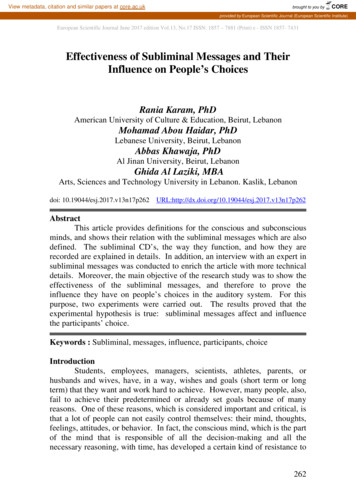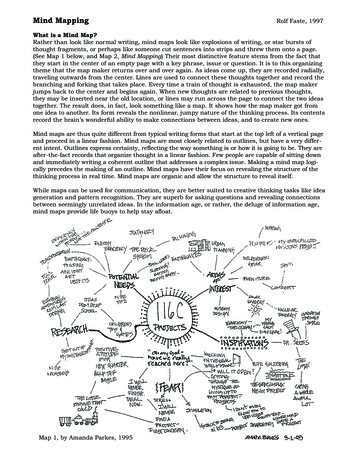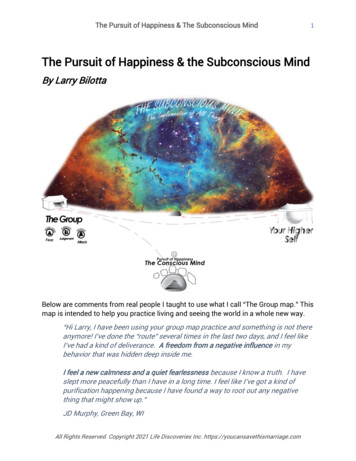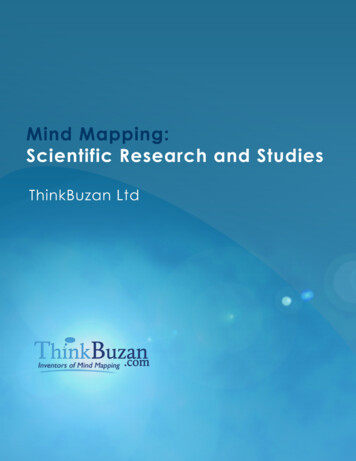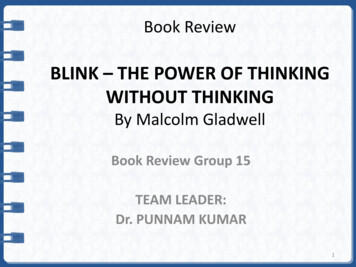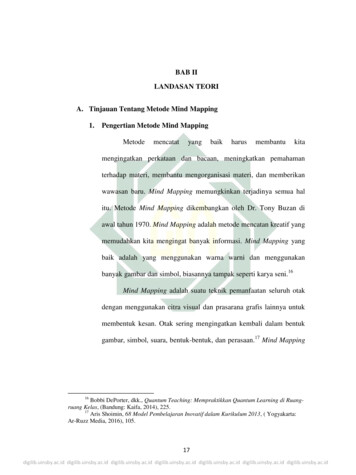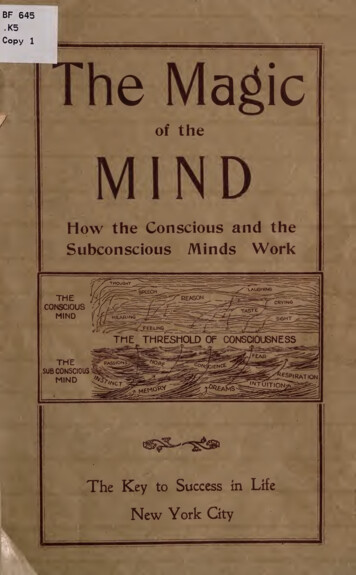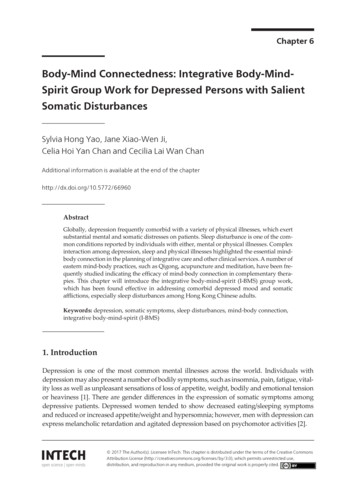
Transcription
Legal NoticeWhile all attempts have been made to verify information provided in thispublication, neither the Author nor the Publisher assumes any responsibility forerrors, omissions, or contrary interpretation of the subject matter herein.This publication is not intended for use as a source of legal, business, career orpsychological advice. The Author and the Publisher assumes no responsibilityfor any injuries suffered or damages or losses incurred during or as a result offollowing this information. All information should be carefully studied,researched independently, and clearly understood before taking any actionbased on the information or advice in this book. All users are advised to retaincompetent counsel to determine if the information contained herein isappropriate for them.The Author and Publisher assume no responsibility or liability whatsoever on thebehalf of any Purchaser or Reader of these materials. The Purchaser or Readerof this publication assumes full responsibility for the use of these materials andinformation.Any perceived slights of specific people or organizations are unintentional.1
IntroductionDo you dream of being the CEO of a Fortune 500 company? Have you wantedto buy that new home you’ve dreamed of for so many years? Exactly what isyour idea of success?Success is having achieved that which you determine you will do!YOU determine what success is for you. It’s not based on any judgment otherthan your own. It’s not dependent upon materialistic measurements. And, forsome, success is the journey, itself.Success may be something material, such as money or a new home. It could besomething egotistical, as the power and notoriety that comes with the position ofCEO. It could be emotional, as finding love and commitment. Success mayeven be unselfish and altruistic, as seeing children in third world countrieshealthy and safe. Success has no particular name or identity. There is no onemethod to describe what success is, other than the definition above. It meanssomething different to each individual.All successful people, however, have one thing in common — determination!To be a success, you must first determine to be so. Though not always aconscious decision, the seed that leads to action is to first determine.Diane’s story is a great example of having a desire in the consciousmind, and the subconscious processing it as a determination. Diane’slove of writing began in middle school, because her friends were writingshort romance stories about their favorite music idols. Diane thought she2
would give it a try. Her stories became so popular that she began writingthem in segments. Her classmates couldn’t wait to get the nextinstallment. From that point, she wrote different types of things — poetry,philosophy, and sometimes only her thoughts. She won a few writingcompetitions in school, but most of her writings were for herself. It wasonly a hobby. Something she did to pass time, or a way to put herthoughts on paper. When she entered college, she didn’t give writing asecond thought. She graduated with a dual degree in psychology andbusiness management. Diane worked in business for several years;then, “fell” into the writing profession.She thought it just happened; but in truth, each position she held hadsome writing responsibilities — first, business reports and editingmanuals, then putting together and writing a monthly newsletter for thefirm. At the job she “fell” into, she started as a secretary, after havingmoved to another state. Being used to a heavier workload, they finallygave her a small job to do for their technical writer, who was writing anemployee handbook for the firm. Between her regular duties, Diane,who had written a similar handbook at her previous job, filled in thegaps, extended the contents so the handbook was complete, and gave adraft to the technical writer for review. Her assignment was only to layout what he’d written. To make a long story short, they offered her a jobas a proposal writer, and then a position as their engineeringdocumentation coordinator, where she wrote customized engineeringmanuals. Though it seemed to Diane that she “fell” into the job ofprofessional writing, she had “determined” it years before while writingthose short stories in middle school. She has now been writingprofessionally for over 20 years, including books and novels. When Ionce asked her why she didn’t just go to school for English orJournalism, she said she never thought about it. Her love was3
psychology. She considered herself to be a halfway decent writer andalways believed she would write on some level. She didn’t discountwriting professionally; it just never crossed her mind.So, what was Diane’s problem? Though on a subconscious level, she had“determined” to be a writer. Why did it take so long? Because there was noclear goal in which .to believe!Being successful is a two-part process — determination and belief! Both ofwhich begin in the mind. Diane was fortunate that her determination to writebecame a career. She began to believe, because the determination wascreating opportunities — her bosses praised her writing and gave her more,college professors praised her abilities, and once a man wept after having readone of her poems. That’s when she began to believe in her ability to write. Shebegan to believe she had talent — if she hadn’t, she would not be a writertoday. It was enough to thrust her forward to enter the profession her heartdesired. She might have achieved her success much sooner had she beenconsciously working toward it.It’s important to be consciously on your path to success, and equally importantto prepare your mind, spirit and body for the success you seek. It’s not enoughto be an anonymous member of society, who lets others decide your fate. Toallow life to “pull you along” creates conflicts, resentments and lostopportunities. Without a clear notion of where you want to be means that you: End up in situations not to your liking. Why? Because if you don’thave a clear idea of what you want in life, you get whatever is left over,causing conflicts by not having what you believe you desire but never4
determined, being in one bad relationship after another, being in onebad job after another, and so on. Resent your life and many of the people in it. This isn’t what youimagined for yourself! In truth, if you had taken the time to truly imaginesomething for yourself and went beyond dreaming and wanting it todetermining and believing, you would be there now and would not bereading this book. Pass up many opportunities that could help you get to where you’regoing faster. You don’t take risks — you play it safe. Why? You don’trecognize the opportunities as such, when they present themselves.The chapters that follow show you the steps to take to change your life NOW!We teach you how to be consciously on your path. It’s never too late to start.The principles herein are used for any type of success you seek, regardless ofwhat it is.So, get ready to open yourself to new opportunities and to succeed in any wayyou desire — you can be anything at any time, anywhere. You only need toopen your mind to the possibilities, then . Change Your Mind — ChangeYour Life!“If you think you can orYou think you can’t,You are always right!”Henry Ford5
Table of ContentsLegal Notice . 1Introduction . 2Open Your Mind to the Possibilities . 7Who Are You? . 19Rewrite Your Reality . 26Give to Succeed . 43Silence Your Mind . 51Believe It Now! . 60Become Inspired . 66Trade-Offs . 70Success from Chaos . 79In Summary . 886
Open Your Mind to the PossibilitiesDetermination and belief are the starting points for success. They open you tonew opportunities to do and be anything you desire, and you only need asubconscious thought to plant the seed. How do we do this?The first and most important element of success is to .open your mind.A closed mind seals off creative solutions and eliminates any possibility for newopportunities. A closed mind keeps you where you are in life, where you alwayshave been, and will continue to be. A closed mind creates: Constant struggle to achieve or get ahead, Constant conflicts and obstacles, the ever-present resentments that reartheir ugly heads for each new situation you encounter, Remorse of not doing or having what you truly dream, and The envy you feel each time you meet, read or hear about someonemore successful than you, knowing you should be in that person’sshoes.None of these feelings are conducive to success. Envision wild horses pent upin a corral. They yearn to be free. As long as the fences are up and the gate islocked, the wild horses that desire freedom more than life, itself, will never be7
free. What does this do to them? They become angry and willing to trample theperson who caged them, just to get free. They blame and resent their keeper fortheir situation. Each time they see other horses roaming free in the distance, alltheir anger, resentment and hatred surfaces; and they envy the freedom of theother horses. Now, see these wild horses as you and your dream for success,corralled and caged by your closed mind. Can you see how, as the horses, youbecome angry, resentful, hating, and envious? Can you see how a closed mindand the emotions it provokes affect your reactions to situations? Wild horses willkill their keeper for freedom and react viciously at seeing other horses that arefree. What reactions do you have to situations, where you feel anger,resentment or blame?All the horses need to gain their freedom is to unlock and open the gate. All youneed do to be on your path to achieving success is to open your mind.When you truly open your mind, the anger, resentments, hatred and envy aregone; however, it takes some work on your part. Let’s look at how the mindworks.A thought, just like an action, is energy in motion. Emotional thoughts carryeven more energy. When you create a thought, especially one you feelemotional about (such as your dream of success), you have created energy thatgoes out to the universe1 and allows you to explore, create and grow thethought. The process takes care of itself.We all have thoughts, but we don’t all achieve our dreams. That’s becausethoughts may be negative or positive in nature. Even thoughts you believeare positive may, in truth, be negative to achievement. For example, your1We use the term “universe” in this book to include all readers. The term could just aseasily be God, Allah, Yahweh, or any other source you believe controls this universe inwhich we live.8
dream is to own a new home. The thought you constantly hold is, “I want to buya new home.” This sounds like a positive thought, but it’s actually keeping youfrom getting your new home. Why? The phrase “I want” keeps you wanting tobuy a new home, rather than actually buying it. So, you continue to want to buyit — never achieving your goal.Focus is another problem in how thoughts are formulated in our thoughts. Youconstantly think about that new home you “want” to buy. You look at differenthomes and floor plans, comb the “for sale” home classifieds, pick out the coloryou’ll paint the outside, look at landscaping ideas, and so on. You wouldbelieve that this is a positive focus, because it keeps the goal constantly in yourmind and you actions are that of someone who is buying a new home. Theproblem, however, is that the focus is on “getting” versus “doing”. Rather thanmoving toward your goal, you are dreaming about it.(We’ll cover both of these negative thought patterns, as well as other elementscovered in this chapter, and how to make them positive in the chapter entitled,“Rewriting Your Reality”. Here, we want to emphasize the power of your mind,and how thoughts create your reality.)With an open mind, you plant the seed, distance yourself from it, and let theuniverse do the rest. You must, however, be open to all possibilities withoutexception. That means only positive thinking, no attachments, and nolabeling.An open and positive mind allows the universe to act upon your inner thoughtenergy and create that which you seek. It’s like watching a little miracle takeplace. It can astound you, when you realize it’s happening.9
Years ago, after a divorce from a financially irresponsible spouse, Bethwrote down goals for her children and herself — to have enough food onthe table, a good roof over their heads, and a decent car to drive in tenyears. Many years later, she was preparing to close on a townhouse andhad just picked up a new car. Then, it hit her — she remembered thoselong-ago goals that she hadn’t even thought of since. She counted theyears and was amazed. The closing on her house would be exactly twomonths shy of ten years from the divorce date. Beth realized then thatshe should have written in five years instead of ten!As you can see, distancing yourself from the goals and just working towardthem brings success. Beth determined; then, she believed, because she coulddo no less for her children. She just kept working to do better. The process tookcare of itself. Yet, Beth never saw it coming, until it already had arrived.However, Beth probably missed a lot of opportunities along the way and wentthrough a lot more struggle, because she wasn’t consciously moving toward hergoals.Let’s look at some elements of thinking that hold us back from consciouslymoving toward success.Energy ExpandsYour thoughts become energy. If your thoughts are negative, the energy isnegative; if positive, then the energy is positive. When emotions becomeinvolved with the thoughts, the energy is even stronger. The energy, however,doesn’t remain dormant — it expands. It expands each time you think yourthought. Remember our example, “I want to buy a new home.” The more youthink this thought, the energy expands and builds, and the stronger the thoughtbecomes. Dreaming of your “want” builds the energy more.10
As energy builds and gains strength, it begins to attract like energy. Like amagnet, the energy attracts other like matter to it. Since the energy is insideyou, it attracts the like matter to you. If your thoughts lean toward the negative,then you are attracting negative matter — dead end jobs, horrible bosses, badrelationships, never achieving that which you most want, constant struggle,conflicts, built up anger, and so on. Whereas, if your thoughts are positive, youattract positive outcomes and situations.As you can see, negative thoughts and energy weaken you and your ability toachieve. Positive thoughts and energy empower you. Whatever you think, youattract back to you in greater degrees. Literally, your thoughts do create yourreality. Evidence is all around you. Are your thoughts negative or positive? Donegative or positive situations, events and people surround you?Beyond Thoughts. If your thoughts and the energy attached to them arenegative, what type of speech and actions will you put forth? Negative! What isinside you (thoughts) is how you respond to life. If your thoughts are negative,then your speech and actions are negative, too. Likewise, if your thoughts arepositive, then so is your speech and actions, which also add to the building andattracting of like energy.For example, if you keep “wanting” to buy a new home, you becomefrustrated, angry and begin to blame others for not achieving your goal— not paid enough at work, lenders won’t give you a break, and so on.These emotions spill out into your speech and actions, especially yourreactions. A lender turns you down, and you become angry. He mighthave planned to tell you what you needed to do to become eligible orsuggest a particular lender who might be able to help, but you blew upand took your frustration out on him.11
This is called a missed opportunity . all because the negative built internally,spilled out at the wrong time, and at the wrong person. Your thoughts not onlydefine your reality, but they define who you are and how you act, as well.Enculturation ProgrammingAnother element of thinking and having an open mind is our programmingthrough enculturation. Enculturation is our environment from the time of ourbirth to this moment. It includes our culture, friends, the people we have metalong the way, family (especially, our parents), authority encounters (teachers,police officers, etc.), education — virtually every person, place or thing we haveencountered within our lifetime!That’s a lot of influence, and this influence has a way of programming our mindsto be something other than who we truly are. It causes prejudices, dislikes, andbelieving certain things are “right” while others are “wrong”. It leaves manychoices unexplored, many opportunities missed, and many pathways labeled as“wrong”.Enculturation programming, especially at an early age by your parents andfamily, enable you to fit within your culture, your community, and the type of lifethey expect you will have. It’s done with the best of intentions. Some is doneoutwardly. Some is subconscious. Most is done, because their parents did it tothem. We accept it in our youth, rebel against it in our teens, and usually do itto our own children because it helped us turn out okay.Some of this programming is necessary to keep us safe, healthy and sane.However, a lot of it clogs our thinking and suppresses creativity. It’s this partthat causes a closed mind, holding you back and keeping you attached to the12
past. Once you can let go of this programming, doors of possibility and successopen to you.A lot of this mental programming is easy to recognize. Each has a recordedtape that runs in your mind. Do you ever catch yourself sounding just like yourmother or father? Say a phrase your grandmother always said? Do something,because someone else always did it that way? Feel a particular way aboutsomeone or something, because that’s the correct way to feel? Becomerepulsed by something, because you’ve always felt that way? These are allprogramming tapes. You need to begin recognizing them and eliminating themfrom your mind.Programming causes attachments to the past — essentially, attachment to theprogramming that was done in the past. These attachments cause negativethoughts, limiting self-speech, limiting actions and responses, and the need to“be right”. None of these traits are conducive to being open or to achieve yourgoals.Self-Speech. This is what we mentally say to ourselves and to others aboutourselves. It limits us by our own self-labels.“I’m not good enough to do that job.”“I’m not attractive enough to get that girl to date me.”“I’m too shy.”“I always fail at that.”“My father was right. I’ll never amount to much.”“My pastor says we’re not deserving of good things. God will providewhat He will for me.”13
These are only a fraction of the negative things we say to ourselves. You couldprobably list many pages of your own limiting self-speech. Most comes from ourprogramming, as the examples above. From there, we create our own negativelabels about ourselves. In this wonderful world in which we live, it’s amazinghow very few people truly like themselves. Their self-speech defines them, justas surely as it defines their reality. It’s called a .self-fulfilling prophecy — you say you are, and so you become!Self-fulfilling prophecies, usually from your early programming, causes thedoubt and fear whenever you wish to take a leap of faith and risk something.They pull you back to your comfort zone and keep you in your corral. Theykeep your expectations for yourself, others and events low, including limitingyour capabilities, talent, potential and opportunities. They keep you fromlistening to crazy schemes that just could be your path to success. Your parentswould never have considered such schemes, and you’re not about to either!Need to Be Right. This is a symptom of attachments and enculturationprogramming, generally from a very influential person, such as a parent.Whether you believe it or not, you have to be right! The programming is sostrong that it’s a conditioned reflex. You’ll argue your point until you’re blue inthe face. Ever have a time when you wondered why you argued about the topicat all — it wasn’t even important to you afterward, or you could actually see theother person’s point? This is a result of programming; and unfortunately, doesn’tmake you many new friends (unless, they are forced to be around you).To have an open mind and achieve your goals, you must let go of this need tobe right, the limiting self-speech, the programming, and the negative thoughts.You may determine to achieve a goal, but all of this negativeness will keep youfrom believing it.14
ExercisesYou cannot develop an open mind without a bit of mental work. We provideexercises at the end of each chapter to help you. The results of the exercisesyou do here are used in later exercises. Don’t worry about your answers — noone else need see them. Be as honest as you can be. It will assist you greatly totake a spiral notepad and use as a journal for this work. You may find it helpfulin later months to have your notes to review from time to time.Exercise #1 — Examine Your ThoughtsLook at your current situation and the success you seek. Write down in your journal your success goal (if you have several,choose only one for the exercise and use it for all the exercises withinthis book). Make several copies of the table on page 16. For the next seven days (do not skip any days), jot down all negativethoughts, speech and actions you have in the first column of yourtable, whether you believe they may affect your goal or not. Use asmany pages of tables as needed. At first, you won’t always catchyourself. As the week passes, you’ll begin catching your negativethoughts, speech and actions more often.15
NegativeProgrammingSelf-SpeechNeed to Be RightWhat:Who:Truth:What:Who:Truth:16
Exercise #2 — The Influence of ProgrammingUsing the table from Exercise #1, do the following: For each negative listed in column one, determine if it came fromprogramming, from whom, and how you may have caused the situation. Then, determine what self-speech you contribute to keeping thisprogramming alive within your life and why you need to be right aboutit. Begin the “need to be right” statement with, “If I’m not right, then .”The example continues on the next page.See an example of a completed table on the next page.Once you have completed all the exercises in thebook, you may wish to continue Exercises #1 and#2, until you begin to see the negative thoughts,speech and actions substantially decrease. Keepthem in your journal.17
NegativeI like this guy, buthe won’t noticeme.I could do myboss’ job betterthan him! Whodoes he think heis?ProgrammingWhat: Guys don’tlike me, becausethey never askedme out.Who: My motheralways told othershow shy I was,and I alwaysreacted withshyness.Truth: Maybe Iwasn’t asked out,because theynever had achance to knowMe?What: I wasalways taught thatpeople whoearned their livingworked hard. Thisguy doesn’t domuch of anything.Who: My father,who worked in asteel mill all hislife.Truth: My fatherwas stuck in hisjob, because hedidn’t have theresources or driveto rise above it. Idon’t truly knoweverything myboss does.Self-SpeechI’m too shy tomeet guys.Need to Be RightIf I’m not right,then they have achance to get toknow me, andthey may not likeme because I’mugly or somethingequallydepressing.I have to workhard to get ahead,even if thatmeans workingextra hours eachweek — whetherit’s needed or not.If I’m not right,then I have toadmit that I feelunder-appreciatedin this job. Then,I’d have to facethe prospect ofhunting for a newjob, which Idetest.18
Who Are You?To develop an open mind, it’s essential to take an honest look at who you trulyare. It’s a difficult question to answer. You may believe you know, but seldom doyou truly know without outside input. In 1955, Joseph Luft and Harry Inghamdeveloped the Johari Window, named for both their first names of Joseph andHarry. The Johari Window helps you to better understand your personality.The Window is made up of four panes, representing the four areas ofpersonality.1. Only You Know2. You Show to OthersThat part of yourselfthat only you knowThat part of yourselfthat you know and sharewith others3. Only Others Know4. No One KnowsThat part of yourselfthat others see, butthat you are unawareof its existenceThat part of yourselfthat no one knows —not yourself or othersQuadrant #1 — Only You Know. This is the area of yourself that you do notwish to disclose to anyone else. It’s the very private and vulnerable part of yourpersonality that holds your fears and doubts. It holds any embarrassing orhurtful event that you did or has happened to you. You choose very carefullywhom you allow to know this part of you, if anyone at all.19
Quadrant #2 — You Show to Others. This is the area of your personality thatyou share with others in varying degrees, depending upon your trust level witheach individual. You feel safe and confident with this part of your personalityand the information contained in this quadrant. People are welcome here.Quadrant #3 — Only Others Know. Though you may not be aware, there is apart of your personality, information about you, which other people know, butyou do not. This quadrant holds that part of you. Such knowledge may be badhabits you do without knowing, such as the habit of biting your lip when you’reunsure of something. Maybe, something like the follow example.Dan didn’t realize until he was video taped that, when he speaks, hrlooks like he’s waving down a freight train. He knew he used his handsfor emphasis, but Dan never suspected that he used his hands to suchan extent.Knowledge in this quadrant also may be your potential. Sometimes, others seein us, what we don’t see in ourselves. These are just a few examples. So manythings may reside in this quadrant for you.Quadrant #4 — No One Knows. This area holds any knowledge and potentialthat you or anyone else has yet to discover. Science has proven that we useonly a small portion of our brain’s capacity. Some things from this quadrant,you will discover between now and when you leave this world. The majority of it,you will never know. The fourth quadrant also is the area where dreams aremade real, where new theories are born, where new science is first thought andthen discovered, and where creativity is given birth. New thought develops here.New ideas that change the world develop here. It’s the unknown part of you .the creative part of you.20
How Does This Apply to You? We’ve already shown why it’s important toknow more about you. In the last chapter, we began working in Quadrant #1 ofthe Johari Window in Exercises #1 and #2. To truly answer the question, “Whoare you?, you need to know as much about all four quadrants as possible. Tobe truly open, you need an unflinching self-assessment in order to take fullresponsibility for who you are and where you are on your path of life.ExercisesExercise #3 — Who Are You, Quadrant #1 Make eight copies of the table on the next page. Put seven copies aside. On the remaining copy, complete the table, using ten words or phrases(both negative and positive) to describe each area of yourself and yourpersonality.Exercise #4 — Who Are You, Quadrant #2, Part 1 Using another copy of the table, complete it again as you believe otherssee you. You should now have two tables completed with six blank tablesremaining. Store the completed copies of the tables for Exercises #3 and#4 in your journal for now.21
Insert 10 words/phrases that describe:PhysicalTemperament Personality BehaviorsAppearance(mood)(good/bad)Philosophy TotalofOverallLifePerson22
Exercise #5 — Who Are You, Quadrant #2, Part 2 Now, choose five individuals that you would like to know how they feelabout you, and one truly close friend/relative that you trust. Of the fiveindividuals, some should be coworkers, a boss, close friends and/orrelatives. Mix it up a bit. You want a range of people with whom youassociate. Meet with the close, trusted friend/relative, and tell him/her what you aredoing. “I’m participating in a workshop on self-growth” is a goodexample, with details of what the other five people will be asked to do.Ask if he/she would be willing to have envelopes mailed to them tocollate into a similar table, destroy the five tables received in the mail,and then giving the collated table to you. Give a copy of the table to yourtrusted friend/relative to use for collating the information received. Fold the five remaining copies of the table and insert into generic,stamped envelopes addressed to your close friend/relative (thereshould be no way to differentiate between the envelopes or copies of thetables). Put the close friend/relative’s address as the return address,too. Meet with each of the five chosen individuals, again explaining what youare doing. Ask each of them if they would
need do to be on your path to achieving success is to open your mind. When you truly open your mind, the anger, resentments, hatred and envy are gone; however, it takes some work on your part. Let's look at how the mind works. A thought, just like an action, is energy in motion. Emotional thoughts carry even more energy.

